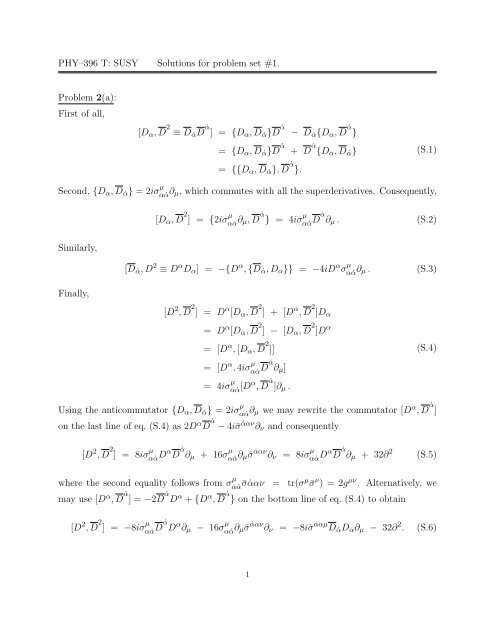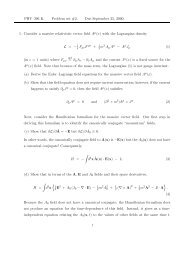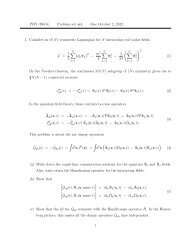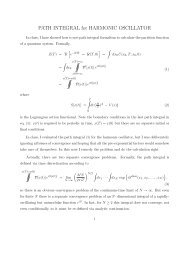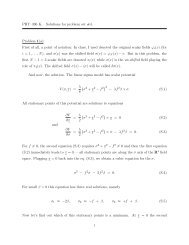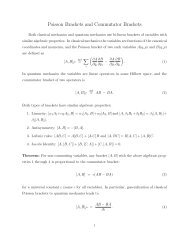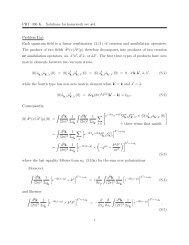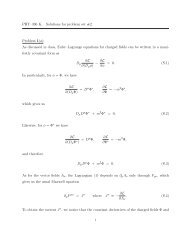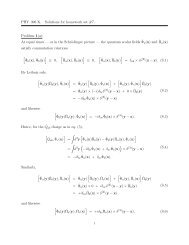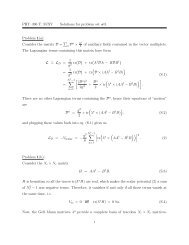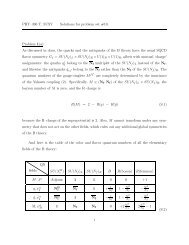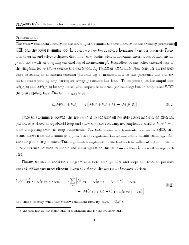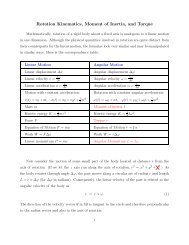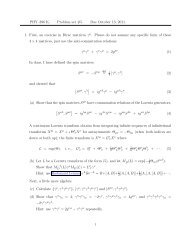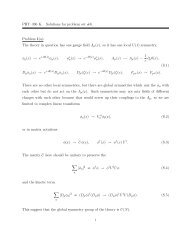PHYâ396 T: SUSY Solutions for problem set #1. Problem 2(a): First ...
PHYâ396 T: SUSY Solutions for problem set #1. Problem 2(a): First ...
PHYâ396 T: SUSY Solutions for problem set #1. Problem 2(a): First ...
You also want an ePaper? Increase the reach of your titles
YUMPU automatically turns print PDFs into web optimized ePapers that Google loves.
D 2 D 2 × D 2 D 2 = 0 =⇒ Π C × Π A = 0, (S.19)D ˙α D 2 D ˙α × D 2 D 2 = 0 =⇒ Π L × Π C = 0, (S.20)D 2 D 2 × D α D 2 D α = 0 =⇒ Π C × Π L = 0, (S.21)D α D 2 D α × D 2 D 2 = 0 =⇒ Π L × Π A = 0, (S.22)D 2 D 2 × D ˙α D 2 D ˙α = 0 =⇒ Π A × Π L = 0. (S.23)<strong>Problem</strong> 2(e):Since DDD ≡ 0, <strong>for</strong> any superfield Y (x, θ, ¯θ), D ˙α D 2 Y = 0, which makes D 2 Y a chiralsuperfield. Consequently, <strong>for</strong> any general superfield X,Π C X = D 2 ×D2X is a chiral superfield.−16∂2 (S.24)Likewise, DDD ≡ 0 makes D 2 × anything an antichiral superfield, hence<strong>for</strong> any X(x, θ, ¯θ), Π A X = D 2 × D2X is an antichiral superfield.−16∂2 (S.25)Finally,Π L X = D α × D2 D α8∂ 2X = D ˙α × D2 D ˙α8∂ 2 X (S.26)satisfies bothD 2 × Π L X = D 2 × D α × · · · = 0(S.27)andD 2 × Π L X = D 2 × D ˙α × · · · = 0,(S.28)which makes Π L X a linear superfield.4
Now consider Π C Φ <strong>for</strong> a chiral superfield Φ(y, θ). Since D ˙α Φ = 0, it follows thatD 2 D 2 Φ = D ˙α [D ˙α , D 2 ]Φ = {D ˙α , [D ˙α , D 2 ]}Φ(S.29)where{D ˙α , [D ˙α , D 2 ]} = −16∂ 2 (S.30)similar to eq. (S.12). ThusD 2 D 2 Φ = −16∂ 2 Φ =⇒ Π C Φ = Φ. (S.31)Similarly, any antichiral superfield Φ satisfies D α Φ = 0 and henceD 2 D 2 Φ = D α [D α , D 2 ]Φ = {D α , [D α , D 2 ]}Φ = −16∂ 2 Φ =⇒ Π A Φ = Φ. (S.32)Finally, <strong>for</strong> a linear superfield LD α D 2 D α L = D α [D 2 , D α ]L = −4iσ µ α ˙α Dα D ˙α ∂ µ L,D ˙α D 2 D ˙α L = D ˙α [D 2 , D ˙α ]L = −D ˙α [D 2 , D ˙α ]L = −4iσ µ α ˙α D ˙α D α ∂ µ L,(S.33)henceD α D 2 D α L ≡ D ˙α D 2 D ˙α L〈〈cf. part (b)〉〉= 1 2 Dα D 2 D α L + 1 2 D ˙αD 2 D ˙α L= −2iσ µ α ˙α ∂ µ{D α , D ˙α }L(S.34)= −2iσ µ α ˙α ∂ µ × 2i¯σ ˙ααν ∂ ν L= +8∂ 2 Land there<strong>for</strong>e Π L L = L.5
<strong>Problem</strong> 3(a):Thanks to D 2 × D α D 2 D α = 0 and D 2 × D α D 2 D α = D 2 × D ˙α D 2 D ˙α = 0, equation (3)impliesD 2 V = − 18m 2 D2 × D α D 2 D α V = 0andD 2 V = − 18m 2 D2 × D α D 2 D α V = 0.This makes the on-shell V a linear superfield. And having established that point, we haveΠ L V = V =⇒ 1 8 Dα D 2 D α V = ∂ 2 V and hence eq. (3) becomes the Klein–Gordon equation(m 2 + ∂ 2 )V = 0.Note that the equation of motion (3) <strong>for</strong> the massive vector field V implies both thelinear superfield equations D 2 V = D 2 V = 0 and the Klein–Gordon equation <strong>for</strong> all thecomponents. This is similar to what happens to the ordinary (non-<strong>SUSY</strong>) massive vectorfield A µ : its free equation of motion∂ µ F µν + m 2 A ν = 0 (S.35)implies both the 4D-transversality equation ∂ µ A µ = 0 and the Klein–Gordon equation (m 2 +∂ 2 )A µ = 0 <strong>for</strong> all the components A µ .<strong>Problem</strong> 3(b):Without gauge fixing, the off-shell vector superfield V has 16 components according toV (x, θ, ¯θ) = C(x) + θ 2 f(x) + ¯θ 2 f ∗ (x) + θ α σ µ α ˙α¯θ ˙α A µ (x) + 1 2 θ2¯θ2 (D(x) − 1 2 ∂2 C(x))+ θ α χ α (x) + θ 2¯θ ˙α (¯λ ˙α (x) +2 i ¯σ ˙ααµ ∂ µ χ α (x))+ ¯θ ˙α ¯χ ˙α (x) + ¯θ 2 θ α (λ α (x) +2 i σµ α ˙α ∂ µ ¯χ ˙α (x)).(S.36)We need to express the D 2 V = D 2 V = 0 equations in component <strong>for</strong>m. This can be donedirectly in the (x, θ, ¯θ) coordinates, but it’s easier to work with (y, θ, ¯θ) coordinates <strong>for</strong> the6
D 2 V and (ȳ, θ, ¯θ) <strong>for</strong> the D 2 V . Indeed, in the (y, θ, ¯θ) coordinatesD ˙α = ∂∂ ¯θ ˙α∣∣∣∣y,θand D 2 = −4∂∣∂(¯θ 2 )∣y,θ(S.37)while in the (ȳ, θ, ¯θ) coordinatesD α = ∂∂θ α ∣∣∣∣ȳ,¯θandD 2 = −4∂∣∂(θ 2 )∣ȳ,¯θ(S.38)Thus, to calculate D 2 V all we need is to change the coordinates from (x, θ, ¯θ) to (y, θ, ¯θ) —which givesV (y, θ, ¯θ) = C(y) + θ 2 f(y) + ¯θ 2 f ∗ (y) + θ α σ µ α ˙α¯θ ˙α( A µ (y) − i∂ µ C(y) )+ 1 2 θ2¯θ2 ( D(y) − ∂ 2 C(y) − i∂ µ A µ (y) )+ θ α χ α (y) + θ 2¯θ (S.39)˙α¯λ ˙α (y)+ ¯θ ˙α ¯χ ˙α (y) + ¯θ 2 θ α( λ α (y) + iσ µ α ˙α ∂ µ ¯χ ˙α (y) )— and then drop the ¯θ 2 factors from terms which have them and discard the terms whichdon’t, thus− 1 4 D2 V (y, θ) = f ∗ (y) + θ α( λ α (y)+iσ µ α ˙α ∂ µ ¯χ ˙α (y) ) + θ 2( D(y)−∂ 2 C(y)−i∂ µ A µ (y) ) . (S.40)Similarly,− 1 4 D2 V (ȳ, ¯θ) = f(ȳ) + ¯θ ˙α(¯λ ˙α (ȳ)+i¯σ ˙ααµ ∂ µ χ α (ȳ) ) + ¯θ 2( D(ȳ)−∂ 2 C(ȳ)+i∂ µ A µ (ȳ) ) . (S.41)According to these <strong>for</strong>mulae, the D 2 V = D 2 V = 0 equations of motion <strong>for</strong> the on-shellsuperfield V expand to component-field equationsf = f ∗ = 0, (S.42)D − ∂ 2 C ± i∂ µ A µ = 0, (S.43)7
λ α + iσ µ α ˙α ∂ µ ¯χ ˙α = 0, (S.44)¯λ ˙α + i¯σ ˙ααµ ∂ µ χ α = 0. (S.45)Note that eq. (S.43) is equivalent toD = ∂ 2 C and ∂ µ A µ = 0. (S.46)Thus, only 4 out of eight bosonic components of V are independent on shell: The 3 componentof the A µ (x) (which is proper <strong>for</strong> the massive vector field in 3 + 1 dimensions), plus onereal scalar C(x). The remaining scalars either vanish or follow C: f = f ∗ = 0 whileD = ∂ 2 C = −m 2 C.<strong>Problem</strong> 3(c):Finally, consider the fermionic components of V . There are 8 of them — χ α , ¯χ ˙α , λ α , and— but they give rise to only 4 physical degrees of freedom because they satisfy first-orderequations of motion. Specifically, there are 4 two-component Weyl equationsλ α = −iσ µ α ˙α ∂ µ ¯χ ˙α , (S.44)¯λ ˙α = −i¯σ ˙ααµ ∂ µ χ α , (S.45)m 2 χ α = −iσ µ α ˙α ∂ µ¯λ ˙α , (S.47)m 2 ¯χ ˙α = −i¯σ ˙ααµ ∂ µ λ α . (S.48)The first two equations here follow from the expansion of D 2 V = D 2 V = 0 as we have alreadyseen in part (b). The other two equations follow from the first two and the Klein-Gordonequations (m 2 + ∂ 2 )(any component) = 0. Indeed,−iσ µ α ˙α ∂ µ¯λ ˙α = −iσ µ α ˙α ∂ µ × (−i)¯σ ˙αβν ∂ ν χ β = −∂ 2 χ α = +m 2 χ α (S.49)and likewise−i¯σ ˙ααµ ∂ µ λ α = −i¯σ ˙ααµ ∂ µ × (−i)σ ν α ˙β ∂ ν ¯χ ˙β = −∂ 2 ¯χ ˙β = +m 2 ¯χ ˙β. (S.50)¯λ ˙αThe Weyl equations (S.44) through (S.48) have unconventional powers of the mass mbecause the χ and the ¯χ fields have a different scaling dimension from the λ and the ¯λ. We8
may remedy that by rescaling χ α ↦→ mχ α and ¯χ ˙α ↦→ m¯χ ˙α , which brings the Weyl equationsto conventional <strong>for</strong>mmλ α + iσ µ α ˙α ∂ µ ¯χ ˙α = mχ α + iσ µ α ˙α ∂ µ¯λ ˙α = 0,m¯λ ˙α + i¯σ ˙ααµ ∂ µ χ α = m¯χ ˙α + i¯σ ˙ααµ ∂ µ λ α = 0.(S.51)We may also package the four Weyl spinor fields into a Dirac spinor fields Ψ(x) and ithermitian conjugate according toΨ =(λαm¯χ ˙α )and Ψ ≡ Ψ † γ 0 =(mχ α , ¯λ ˙α). (S.52)In terms of these Dirac spinors, eqs. (S.44) through (S.48) become the Dirac equations(iγ µ ∂ µ + m)Ψ = 0 and − i∂ µ Ψγ µ + mΨ = 0. (S.53)9


